 |
Fort Point
San Francisco, California, USA
|
|
 |
Constructed: 1853-1861
Used by: United States
Conflicts in which it participated:
None
Also know as: Fort Winfield Scott
|
"The fort at Fort Point" is practically the only fort worth the name fort on the west coast of the United States: Though not a starfort by any stretch of the imagination, it is nonetheless of the era in which we (I) have interest. The reason I've resisted featuring it thus far is because, as one can plainly see above, it's half covered by the Golden Gate Bridge!! |
 |
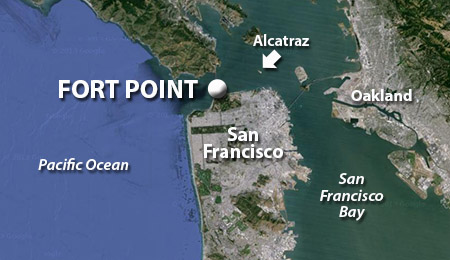 |
|
This, of course, is no fault of Fort Point. Fort Point didn't go to San Francisco's city engineers and beg to have a bridge built over it. It is, however, possibly because of that bridge that the fort still stands today.
The wicked white man first visited the San Francisco Bay area on November 2, 1769, in the form of a Spanish exploration party led by Don Gaspar de Portolá (1716-1784). De Portolá must have immediately reported back to Madrid that this place was frickin' awesome, because seven years later, on September 17, 1776, the Spanish established the Presidio of San Francisco on the southern shore of the Golden Gate, the inlet that connects the Pacific Ocean to San Francisco Bay. Though a somewhat ramshackle "fort" made of adobe, wood and brush, the Presidio served to protect nearby Mission Delores (between 1769 and 1833 Spain established 21 missions through California, intended to spread the blessings of Christianity among the heathen natives), as well as project Spanish power in the region. It was the northernmost Spanish fort on the west coast of the Americas.
|
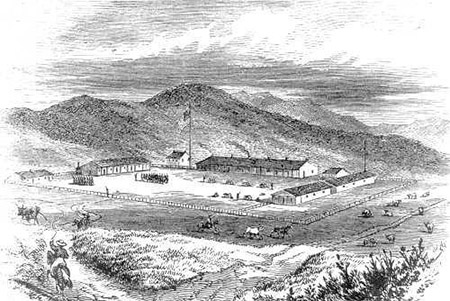 The Presidio of San Francisco in 1850, shortly after being claimed by the US. The Presidio of San Francisco in 1850, shortly after being claimed by the US. |
 |
Projecting power in California didn't prevent Mexico from becoming independent from Spain in 1821. It took a year for word of this event to reach the Presidio. Little support reached this far-flung outpost of the mighty Spanish Empire in the best of times, and the new government of Mexico was even less interested in the Presidio of San Francisco.
The garrison at the Presidio, having gone years without any sign that Mexico City remembered they even existed, finally left for the Sonoma Barracks to the north in 1835, leaving a small detachment of men to make sure the adobe stayed fresh & pretty. |
|
|
A variety of border-related issues (Mexico claimed it had a border, and the US said "Your border is where WE say it is!!") led the US to declare war on Mexico on April 25, 1846. The following Mexican-American War (1846-1848) was ridiculous. Ulysses S. Grant (1822-1885), hero of the US Civil War (1861-1865) and later the 18th president of the United States, described the conflict as "one of the most unjust ever waged by a stronger against a weaker nation."
Unjust or not, John C. Frémont (1813-1890) thought it was swell. An explorer and Lieutenant in the US Army, Frémont and 30 men captured the Sonoma Barracks on June 14, 1846, then jauntily boated across the Golden Gate and captured the Presidio without firing a shot. One of the Mexican cannon that Frémont's force spiked is still on the grounds of the Presidio.
|
After capturing the small garrison at the Presidio and breaking lots of things, Frémont and his merry band departed. Nature slowly had its way with the abandoned fort from 1847 to 1851, during which time California became the 31st United State (September 9, 1850).
While Mexico and Spain were no longer a threat to America's newest, most fabulous port at San Francisco, Great Britain and Russia, of all nations, were.
|
 |
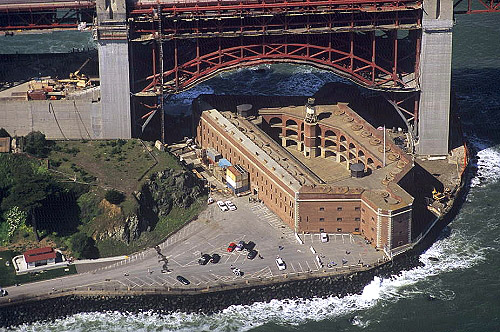 Fort Point today. Yes, I wish this picture were bigger too. |
|
Adobe-and-brush forts were sufficient to defend against little dudes in sombreros wielding pointy sticks, but the navies of Queen Victoria (1819-1901) and Czar Nicholas I (1796-1855) were a different kettle of fish. The US Army Corps of Engineers started work on the Polygonal Fort of Our Current Interest in 1853, "at the foot of the Golden Gate." The Battery at Fort Point is the official name of the structure, but come on, it's a fort, not just a battery. Its construction starting in 1853 made Fort Point one of the very last real forts to be built in the United States: Its relative contemporaries, such as Fort Pulaski, Fort Clinch, Fort Montgomery and Fort Schuyler were all begun around 10 years earlier. Once the US Civil War began in earnest, it became immediately clear that no masonry fortification, regardless of how cleverly and recently built, was capable of withstanding concentrated fire from the latest forms of artillery, which anyone interested in making war against the US was likely to possess. Fort Point was just one stronghold of a defense system intended for San Francisco Bay. Fort Mason was built a bit to the east of the Presidio, and Alcatraz Island was fortified as well.
|
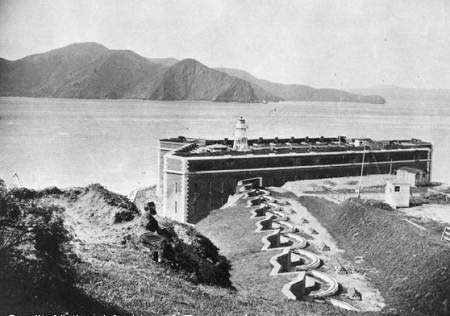 Fort Point at the end of the US Civil War: Thanks, FortWiki.com! Fort Point at the end of the US Civil War: Thanks, FortWiki.com! |
 |
At the outbreak of the US Civil War, Colonel Albert Sydney Johnston (1803-1862) was commander of the US Army Department of the Pacific, based at the Presidio. Though a Texan, Johnston was opposed to secession.
He would leave the US Army shortly after Texas seceded on March 4, 1861, but Johnston took his post seriously enough to ensure that the Presidio's armory was safely secured from southern sympathizers in the area. There would be no Confederate occupation of California. |
|
|
During the US Civil War, Fort Point was kept armed and ready, but wasn't needed to defend San Francisco from the imagined fleet of deadly steam-powered Confederate ironclad airships. The Presidio functioned as a mustering point for volunteer troops that patrolled Indian lands in California and Oregon, while Federal troops were off doing battle with the Southrons.
|
The Confederacy breathed its last in 1865, but there were still plenty of Indians in need of pacification, so the Presidio continued to serve as a base of operations for America's western shenanigans.
In 1882 Fort Point was officially renamed Fort Winfield Scott. Known as "Old Fuss and Feathers," Winfield Scott (1786-1866) remains to this day the longest-serving general in US Army history. From the War of 1812 through the Civil War, Scott commanded troops in just about every military adventure America had to offer. One imagines the only reason Fort Point was so renamed was that somebody at the War Department looked around and realized with sudden, dawning horror that there wasn't already a fort named after Winfield Scott!
|
 |
Fort Point's gun mounts are identical to those at Fort Pulaski, which isn't the least bit surprising in that they mounted many of the same guns. |
|
Winfield would have been disappointed, however, in that his name never really stuck to the fort, to which you'll note we're still referring as Fort Point.
In 1886, troops were withdrawn from the fort momentarily known as Fort Winfield Scott. The Endicott era of American rearmament did Fort Point no good whatsoever. New batteries for the big guns deemed necessary to deal with notionally aggressive modern navies dotted the San Francisco Bay area, but none were installed at Fort Point. Troops heading for the Philippines during the Spanish-American War (1898) and the following Philippine Insurrection (1899-1902) departed from the Presidio, and some were quartered at Fort Point.
|
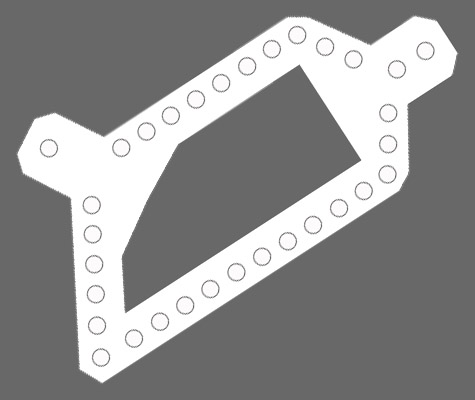 As far as I could find in my standard half-assed research, the Internet had zero full drawings of Fort Point from above. So I made one, based on a partial drawing I found! You're welcome, Internet. As far as I could find in my standard half-assed research, the Internet had zero full drawings of Fort Point from above. So I made one, based on a partial drawing I found! You're welcome, Internet. |
 |
Declared obsolete in 1905, moderately damaged by the Earthquake of 1906, and then abandoned for military purposes in 1914. What else could possibly go wrong for poor, heroic Fort Point?!
The Golden Gate Bridge. Plans for the bridge in the 1930's included the intention to raze Fort Point, but riding to the rescue came the chief engineer of the Golden Gate Bridge, Joseph Strauss (1870-1938). Strauss said, "While the old fort has no military value now, it remains nevertheless a fine example of the mason's art....It should be preserved and restored as a national monument." Strauss redesigned the bridge to allow for the continued existence of Fort Point. |
|
|
Had it not been for this attention as it related to what is now San Francisco's most universally recognized landmark, Fort Point may well have just crumbled into nothingness, or been destroyed in the name of commercial development. A Starforts.com Distinguished Service in the Name of Pseudo-Starfort Preservation Cross has been posthumously awarded to Mr. Strauss. The Presidio continued to be an important military base, sending troops off to fight in all of the fun Asiatic wars in which the US specialized in the second half of the 20th century, until it was finally deactivated and transferred to the National Park Service in 1994. Today, Fort Point is open Friday through Sunday, 10-5, year 'round. Civil War reenactors frequently march thereabout in a purposeful manner. No fort on the west coast of the US ever came under attack...except one, sort of. On the night of June 21-22, 1942, an Endicott Era battery at the mouth of the Colombia River (next to pseudostarfort Fort Stevens) along Oregon's border with Washington, received 17 shells from the deck gun on the Japanese submarine I-25. The commander of Fort Stevens elected not to fire back, and the only thing destroyed by enemy fire was the backstop for the fort's baseball field. Insert culturally insensitive remark about Japanese sailors needing unfashionable round, thick, black-rimmed glasses here.
|
It's impossible to talk about San Francisco Bay without mentioning Alcatraz. During the US Civil War, Fort Alcatraz was the most heavily-armed fortification on the west coast: By 1868 there were 105 large-caliber guns mounted and ready for action on Alcatraz Island, with an additional 50 cannon tubes lying around unmounted.
Our old friend John C. Frémont purchased Alcatraz Island from a Francis Temple for $5,000 in 1846, planning on turning a tidy profit once the US government realized how goshdarned useful it was, appropriated the island and reimbursed him. In 1850, US president Millard Fillmore (1800-1874) ordered that Alcatraz Island be set aside for military purposes, as California was now a US state and surely everyone with a ship would want to immediately invade it.
|
 |
|
|
The US government later invalidated Frémont's purchase of the island and he was paid nothing. Nothing! Frémont and his family carried the reimbursement fight in court until the 1890's, to no avail.
While the many guns of Fort Alcatraz were never needed to defend San Francisco Bay, beginning in the Civil War the government started imprisoning folks there: Deserters, insubordinate soldiers and Confederate sympathizers were among the first to legally be able to wear the coveted I've been incarcerated at the coolest prison in the universe! T-shirt.
|
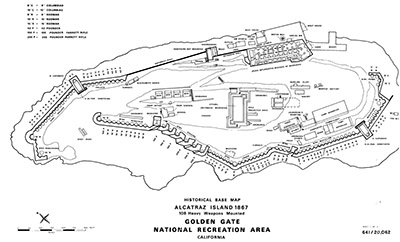 Fort Alcatraz, 1867. Thanks again, Fortwiki.com! Fort Alcatraz, 1867. Thanks again, Fortwiki.com! |
 |
Alcatraz was officially made a military prison in 1868, and named the Western US Military Prison in 1907. In 1909 the army did away with most of the fortlike aspects of Fort Alcatraz, in order to make more room to incarcerate folks in need of incarceratin'.
"Conscientious Objectors" were kept on Alcatraz Island during the First World War (1914-1918) because...we can't have those people just running around free, now can we. In 1934 the army turned Alcatraz Island over to the Federal Prison System, and the rest is history. Well, really, all of this is history. Except for the crack about Japanese sailors needing glasses, which was just needless and shameful. |
|
|
|
|
|
|
|
 |




